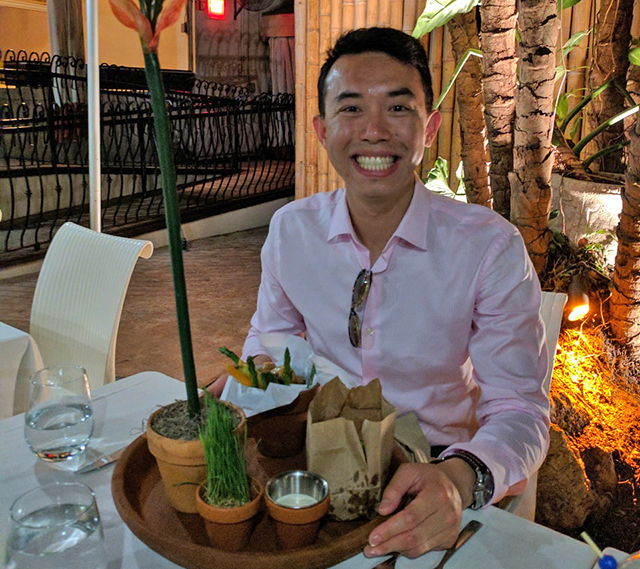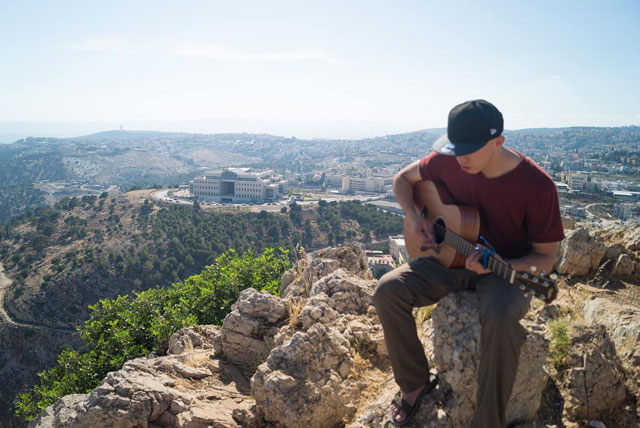Juxtaposing genetics and philosophy. (Photo courtesy of Jeremy Huang)
Jeremy Huang didn’t decide to pursue research because he fell in love with lab work.
His passion for science was sparked by the lights of the Perseid Meteor Shower, playing across the inky night sky as he and his father sat on top of the family’s Volvo, eating jalapeno chips, drinking root beer, and contemplating their place in an infinite universe.
Huang is still asking deep questions, though now about genetics instead of astrophysics, through his work as a bioengineering Ph.D. candidate at the Harvard John A. Paulson School of Engineering and Applied Sciences (SEAS) and Harvard Medical School, jointly advised by George Church, Robert Winthrop Professor Genetics, and Jennifer Lewis, Hansjorg Wyss Professor of Biologically Inspired Engineering.
“I knew I wanted to be in a place where I could really explore revolutionary ideas,” Huang said. “When I decided to come to Harvard, I felt that this would be the best place for me to be different.”
Huang has never had trouble marching to the beat of his own drum.
As a high school student, he enrolled in a summer research program at Stanford, where he helped build a bolometric array to observe electromagnetic waves leftover from the Big Bang. While on campus, Huang ended up attending a conference series for faculty and Ph.D. students.
“They were talking about quasars, black holes, and dark matter—I barely understood a lick of it. But what I got out of it was my first encounter with a scientist I really admired -- Nobel Laurate Martin Perl. He and I were just walking down the path out of the auditorium and he told me: ‘Don’t let anyone say to you that just because you are young, you don’t have anything to offer.’”
Science is storytelling, and I love hearing people’s stories and motivations, and what they’ve found out about themselves and about the world.
Huang took that advice to heart as an EECS undergraduate at the University of California, Berkeley, where he and his lab mates manipulated cells using light-activated phototransistors in the lab of Professor Ming Wu.
Drawing on the interdisciplinary experiences gained from that work, Huang pursued a master’s at the University of California, San Diego, where he used lasers and microfluidics for DNA sequencing. Lacking a strong biology background, he studied hard to catch up as the lab utilized optical technologies in an effort to sequence thousands of base pairs from a single DNA strand.
“A, T, C, and G are the building blocks of life, but when I think about it, I’m just looking at four discrete signals,” he said. “In the Ecker lab at the Salk Institute, I used a lot of engineering principles to interrogate biology. My previous work laid the groundwork for what I am doing now—combining my passions from different fields.”
At an NIH gene sequencing conference where Huang was invited as a plenary speaker, he met Church and felt drawn in by the revolutionary nature of his genetics research. That meeting convinced Huang to join the Church lab, where he now works to push human stem cells to become different organ structures.

Celebrating a successful DARPA grant application at the kickoff in Miami, Florida. (Photo courtesy of Jeremy Huang)
“Right now, the biggest problems in organ transplants are the lack of organs to transplant, and rejection by the patient. But what if we can make different cell types from a patient’s own skin? Can we reprogram pluripotent stem cells into pieces of the brain or liver?” he said. “Proof-of-principles demonstrations have been published before, but we believe we can do it better, faster, and with less cost; we can scale things up.”
Huang and his collaborators manipulate the genes within DNA itself, flipping on and off different biological switches inside a pluripotent stem cell’s nucleus to send very strong signals that drive it to become a different mature cell type.
Their novel method is able to make human-induced pluripotent stem cells into any type of adult cell much more quickly than the weeks that are involved in more common methods.
Huang’s biggest challenge often comes down to the fact that he must visit the lab every day to feed the cells. Stem cell biology is a seven-day-a-week job, and while some days are only a few hours, others stretch well past midnight.
Contemplating existential and philosophical ideas fuels him during those late nights in the lab.
“We have our thing that we do, genetics, but we realize that it is much larger than the field itself. We are trying to improve humanity’s wellbeing, and the only way we can get funding or resources is persuading the public that what we are doing is good,” he said. “Engineering, biology, ethics, philosophy, religion—we are all trying to understand how life works. In our lab, we are trying to bring engineering and biology together in a very tangible way.”
For Huang, a devout Christian, that often involves engaging with clergy, philosophers, academics, and everyday people to explain and explore the implications of his work.

Playing songs near Nazareth, Israel. (Photo courtesy of Jeremy Huang)
As advances in genetic engineering pose potentially controversial choices, Huang draws on many different perspectives—religious and secular—to inform his work. He believes understanding different perspectives, and being able to explain science across disciplines, is the only way researchers can get the support they need.
And for Huang, who is considering a career in academia so he can keep pushing the boundaries of genetics research, the prospect of tackling those interdisciplinary challenges is exciting.
“I like to be able to bridge those gaps and showcase that science and religion can coexist, that I can be a good scientist and a good Christian,“ he said. “To me, science is storytelling, and I love hearing people’s stories and motivations, and what they’ve found out about themselves and about the world.”
Press Contact
Adam Zewe | 617-496-5878 | azewe@seas.harvard.edu
